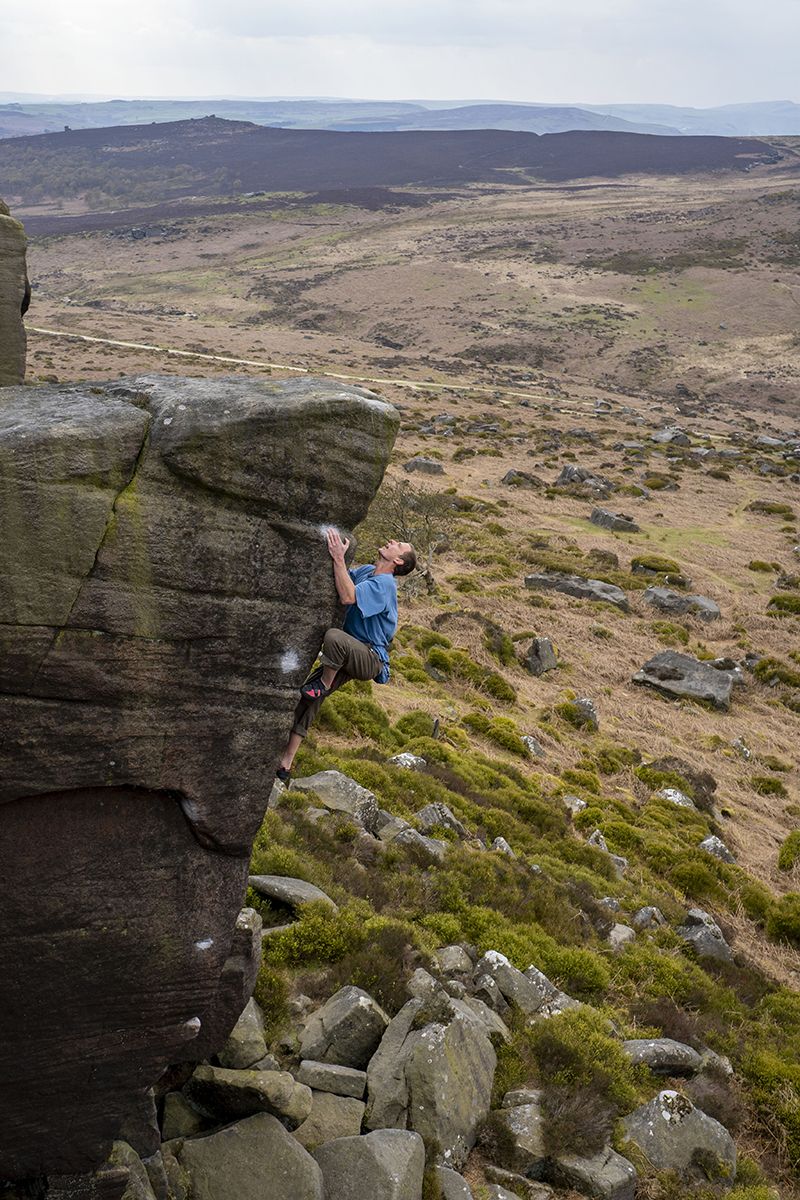
England's Green And Pleasant Land II
Throughout the course of this 'expedition moderne' there have been a handful activities that I’ve attempted to do with some regularity in the destinations we find ourselves, an obvious one being attempts to climb rocks of various shapes and sizes, another constant was my attempts to explore the area we were in, generally by walking somewhat aimlessly for an unspecified period of time and seeing what the location will reveal to me. In the second segment of our time in the UK we were lucky enough to stay with our friends Dave and Mina, who have a devastatingly cute house in a small village in a remote valley of the Peak District. The location of this home has meant that on days where climbing was not possible due to rain or exhaustion I have been able to wander aimlessly, as I so frequently aim to do, and discover little pockets of this countryside that are honestly delightful.
A friend of mine currently residing in Aotearoa but with roots to this land, told me directions to a spot that fits the criteria for an honest delight. By following the road that runs along the stream in the bottom of the valley we temporarily inhabit, I eventually would get to a point where the valley forks in two, at this point there would be a pull over with a cliff up behind it. If I were to climb the stone staircase that traverses this cliff onto its summit, then I would find myself on a spur between these two valleys, a spur covered in wildflowers that catches as much sun as one could hope for, a spur that he had walked down many a time as a younger man when going to the local climbing crag from a small stone house he lived in behind the YHA on top of the hill. The spur in mention was called Bellamy’s Bank, named after botanist, environmentalist and TV personality David Bellamy, as this bank was one of the first places that inspired him on his lifelong dedication to the natural world.
Yesterday, on a day that was predicted as being too damp to warrant climbing but in reality ended up being somewhat pleasant by the afternoon, I followed the directions given to me from my friend back home and found myself on Bellamy’s Bank. Being mid-spring in this hemisphere, the plants are preparing to explode into life and bloom in their annual display of extravagance. The anticipation is palpable. Unfortunately for me, the wildflowers that cover this crest were still in the budding stages and so I would have to imagine the beauty that inspired a botanist who inspired a nation.
Sitting on a stool of limestone at the bottom end of the bank, the sun to my face and the wind to my back, I watched a bird of prey glide in the sky above, scanning the bank for rodents or rabbits, four pigeons climbed and dived further to my right, cooing unrhythmically as they danced in the playful breeze. Here I had an extended moment of reflection on the climbs I’d done, the climbs I wanted to do, and the climbs I’m not sure I’m ready for, as our expedition nears its end.
As I’ve mentioned in a previous report, the Gritstone holds an incredibly fulfilling style of climbing, one that is engaging and committing. In the week that had just passed I was able to climb a handful of climbs which I’d wanted to do since first seeing the classic films showcasing the dangerous style that we’ve currently immersed ourselves in.

One of the climbs that was on my mind before trying it, between sessions and continues to inhabit my thoughts after having climbed it is the Dawes classic Gaia (E8 6c) at Black Rocks. This climb is the actualisation of the statement that climbing on the Grit is like climbing at the Hill, but with more friction. The line, features and moves could easily occur on one of Flock Hill’s many turret-laden castles, however unlike the majority of those climbs, Gaia has the opportunity to protect some of the climbing with two gear placements in the bottom half of the climb. Climbing this was a test of patience for me, although the moves came together fairly quickly on the first top rope inspection, the conditions of the day did not fill me with confidence. Being muggy and warm, I had no faith that I would be able to adhere whilst doing the delicate traverse in the exposed end section of the climb and so made the call not to go for it that day. Instead opting to save it for a day where climbing it would be a more pleasurable experience. Isaac, with his drier, harder skin and confidence in movement went for the lead and cruised up the climb in an efficient waltz.
On our next trip to the crag, two days later and after a delightfully sleepless night, I was able to re-rehearse the moves, reaffirm confidence and then execute a performance I was happy to wait for. The conditions on that day, although not perfect, were far more agreeable and so I was able to have the experience I was after, not worrying about greasing off slopers or overheating and just executing moves comfortably. Gaia is a truly incredible piece of rock, with some of the best movement I’ve experienced on this trip, involving a layback section, compression sequence, groove transfer and sloper encounter, it was a pleasure to climb. This day also involved following Dave up a reinvigorated bold prow next to the imposing Meshuga and climbing up some beautiful friction slabs that, due to the coarse grain of the stone, were surprisingly steeper than the smears we were used to standing on at the Hill. I say 'used to', it’s been four months since I’ve stood on limestone, I wonder if I will feel used to its friction when I return in a little over a week's time.

There are still climbs I want to get done before I leave, one of which being the proud prow of Toby Benham's Simba's Pride, another E8, but hardly comparable to Gaia, this climb is unprotected and involves arm pulling compression moves up a slightly overhanging arête. Similarly to Gaia though, I have already had a session on it and decided to leave it for another day—due to off-putting gusty winds and an exposed position. In honesty, I also put off climbing it that day because I needed a break. Climbing these climbs of consequence, or even trying such climbs has a surprisingly taxing toll on my mental capacity. The most frightening time I find when attempting these challenges is the moment before you go for it. If everything goes as planned, deciding is often the scariest bit, once you start climbing your mind stops worrying about the danger, or the possibility of failure, and is only focused on the execution of the sequence. The mental toll, or at times I feel the emotional toll on these decisions is exponentially exhausting. Having tried climbs of this nature almost every day since being back in the Peak District has meant I no longer have the capacity to go for them as soon as I am comfortable with the movement. I intend to climb Simba’s Pride—when the day is right and I am less exhausted. Hopefully that day comes before our flight back home, if not, it’s something to come back for on another inevitable trip.

Another climb that is on my mind—but with less urgency than that of the climb mentioned in the previous paragraph—is the buttress a hundred metres or so south of the aforementioned climb; Dynamics of Change (E9 7a). I'm not sure I’ve tried a climb with more variety of movement in such opposing styles as this one, and although I have for some reason an inexplicable desire to climb this buttress, I think it wise for physical and mental wellbeing to save it for a time where the finality of the trip is not as pressing. It is comforting to have something to come back for though, something whispering away in the back of my mind asking to be climbed. It’s also interesting to see the step up from the climbs I’ve tried briefly on this trip to this one. Whilst not feeling unattainable, it also feels like a more serious endeavour than the two climbs mentioned in depth in this report and the myriad of lower E grade climbs that we’ve rambled around on whilst visiting this country.
Across the valley, over the river that flows down beneath the bank named after the botanist who was inspired by wild flowers of unwitnessed beauty, there lies a house situated on the skyline angled in such a manner that from my perspective I can see two of its stone walls; one illuminated by the sun and one cast in shadow. The only reason I mention this structure is because it is the focal point of the landscape I am currently marvelling at. A landscape which is clear evidence to the inspiration painters (classified under the label of romanticism) found hundreds of years ago which spurred them to paint such landscape paintings that are still appreciated today.
These paintings, as I recall, have a number of characterisable qualities, one of which being the palette of colours used, which gives the impression of a haze or mist falling over the vista, often depicted as starting in the middle distance and continuing off until the sky meets with the earth. This same haze I witnessed sitting on my stool of limestone, between myself and the house on the hill. A further quality of such paintings which I also witness in the landscape in front of me are dramatic cloudscapes; mountains and valleys in cloud form, backlit by golden light creating auras around them. The density of the clouds reflected in the depths of the purple shadows on their underside and the softness of their texture seen in the golden glow of the edges. Ever changing and ever captivating they crown this vista. There is a subtle beauty to this scenery, a peaceful quiet not only in the sounds of the birds chirping, the wind blowing and the stream trickling, but a quiet in the colours of the hills, the light on the tree tops and the contours of the valleys.
I entertained the idea, whilst sitting on my stool, of returning to this country. More so than any other destination on this trip I’ve enjoyed the climbing, the style, the lines, and I’ve also enjoyed the setting; the narrow winding roads, the dry stone walls, the mossy woodlands with wild garlic covering the ground. I enjoy the thought of having more time to immerse myself in the gritstone, and perhaps sit again atop Bellamy’s Bank, witness the flowers in bloom and look across the valley and see that house on the hill.
This has been the final stop on our expedition across continents and I feel this is my last report of this nature. We intend to write some more sensical writing about what we’ve experienced away from home and how that relates to our local climbing—both through the eyes of environmental impact and in relation to grading climbs through difficulty and also danger. For now, I would like to thank the readers who have read one, some, or all of these reports. I hope I’ve written at least one thing that you’ve found interesting.
-by Matt Corbishley
Main photo: Sam Pratt
